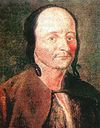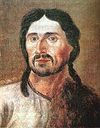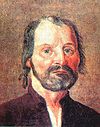
Revolt of Horea, Closca and Crisan
Encyclopedia





Transylvania
Transylvania is a historical region in the central part of Romania. Bounded on the east and south by the Carpathian mountain range, historical Transylvania extended in the west to the Apuseni Mountains; however, the term sometimes encompasses not only Transylvania proper, but also the historical...
, but it soon spread all throughout the Apuseni Mountains
Apuseni Mountains
The Apuseni Mountains is a mountain range in Transylvania, Romania, which belongs to the Western Carpathians, also called Occidentali in Romanian. Their name translates from Romanian as Mountains "of the sunset" i.e. "western". The highest peak is "Cucurbăta Mare" - 1849 metres, also called Bihor...
. Their main demands were related to the feudal serf
SERF
A spin exchange relaxation-free magnetometer is a type of magnetometer developed at Princeton University in the early 2000s. SERF magnetometers measure magnetic fields by using lasers to detect the interaction between alkali metal atoms in a vapor and the magnetic field.The name for the technique...
dom and the lack of political equality between Romanians
Romanians
The Romanians are an ethnic group native to Romania, who speak Romanian; they are the majority inhabitants of Romania....
and other ethnicities of Transylvania.
The leaders were Horea (Vasile Ursu Nicola
Vasile Ursu Nicola
Vasile Ursu Nicola, known as Horea, was a Transylvanian Romanian leader of the Revolt of Horea, Cloşca and Crişan in 1784-85. After the revolt was defeated, he was executed by being broken on the wheel....
(1731 - 1785)), Cloșca (Ion Oargă (1747 - 1785)) and Crișan (Marcu Giurgiu (1733 - 1785)).
They fought at Câmpeni
Câmpeni
Câmpeni is a town in Alba County, Transylvania, Romania. As of July 2002 the town had a population of 8,080 inhabitants...
, Abrud
Abrud
Abrud is a town in the north-western part of Alba County, Transylvania, Romania, located on the river Abrud. It administers three villages: Abrud-Sat, Gura Cornei and Soharu.-Population:...
and Roșia and defeated the Austrian Imperial Army at Brad on 27 November 1784.
The revolt was crushed on 28 February 1785 at Dealul Furcilor (Forks Hill), Alba-Iulia, and afterwards the leaders were caught. Horea and Cloșca were executed by breaking on the wheel
Breaking wheel
The breaking wheel, also known as the Catherine wheel or simply the wheel, was a torture device used for capital punishment in the Middle Ages and early modern times for public execution by bludgeoning to death...
. Crișan hanged himself on the night before the execution.

